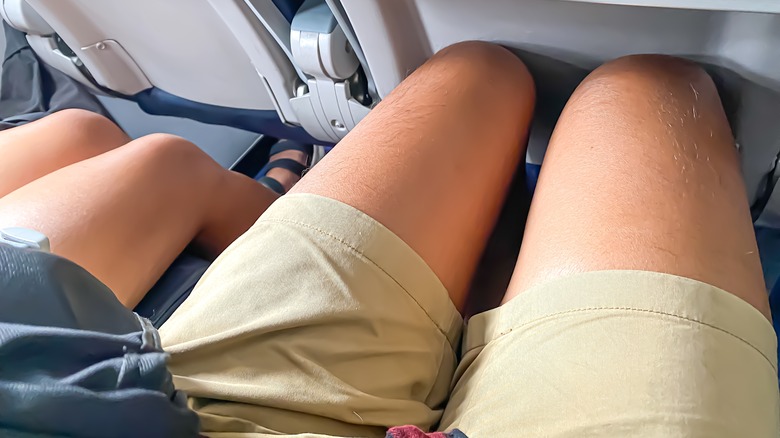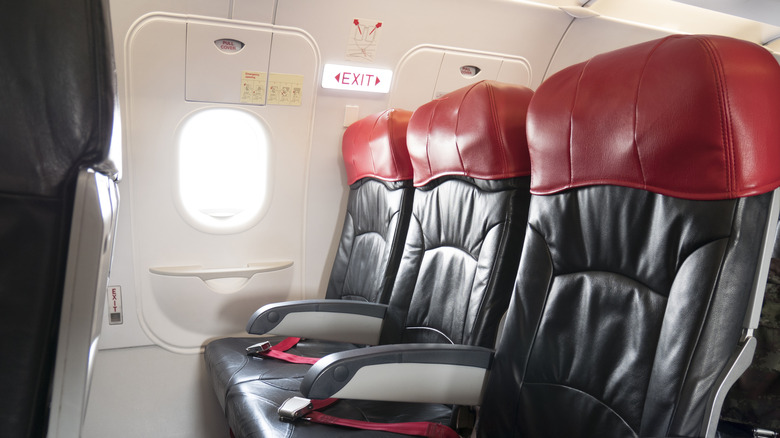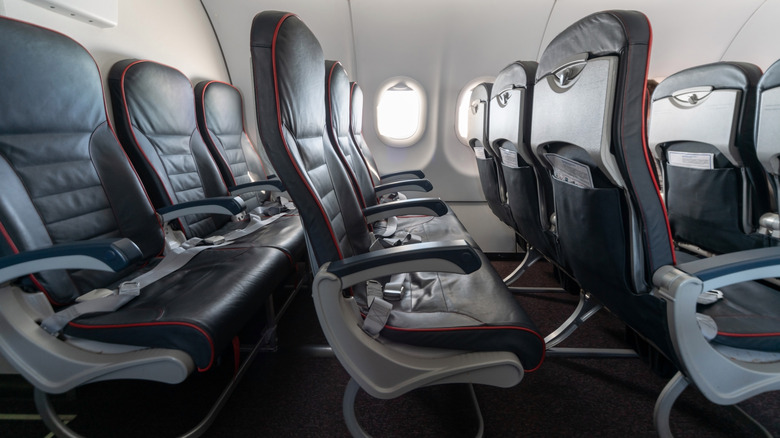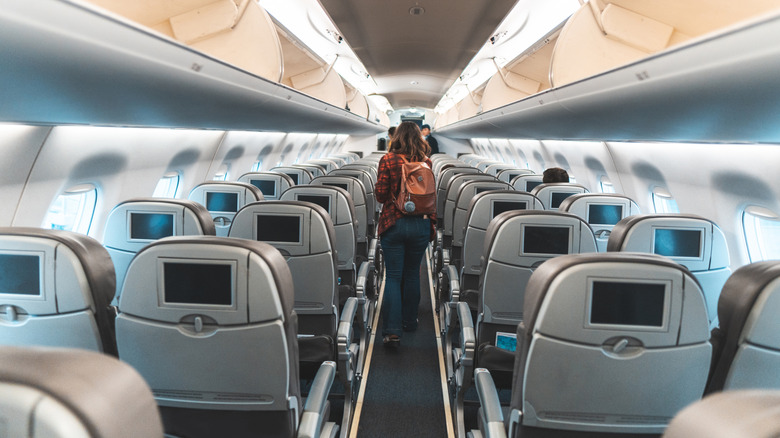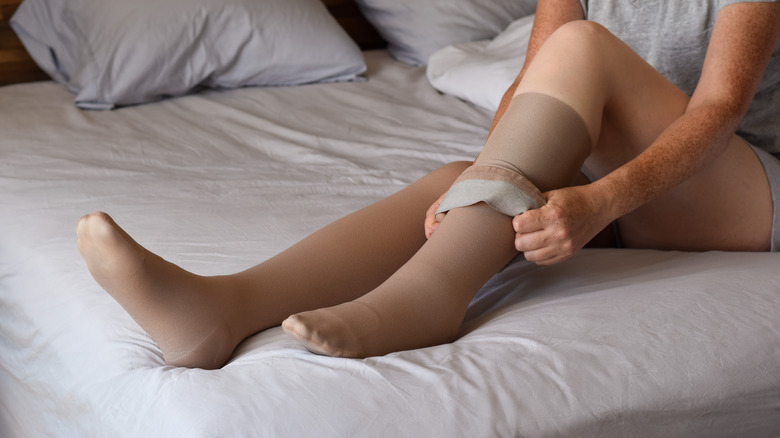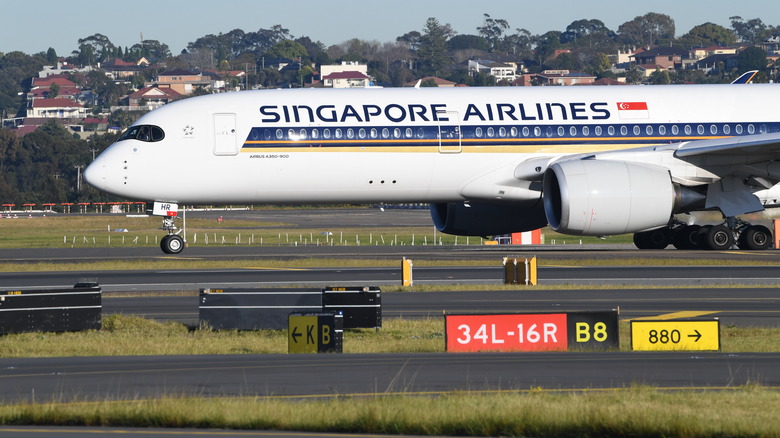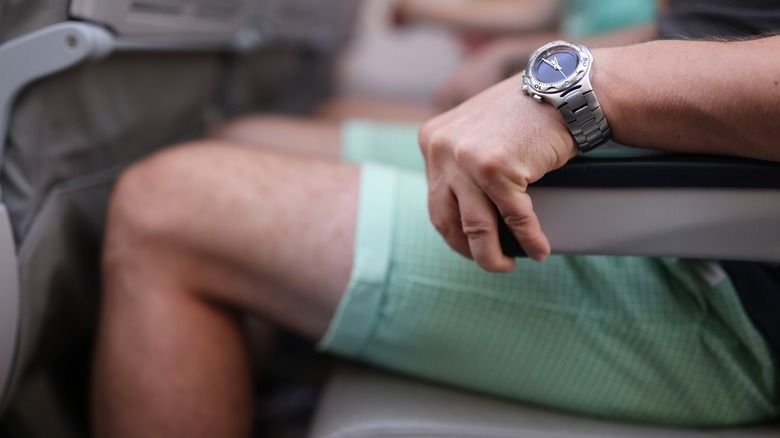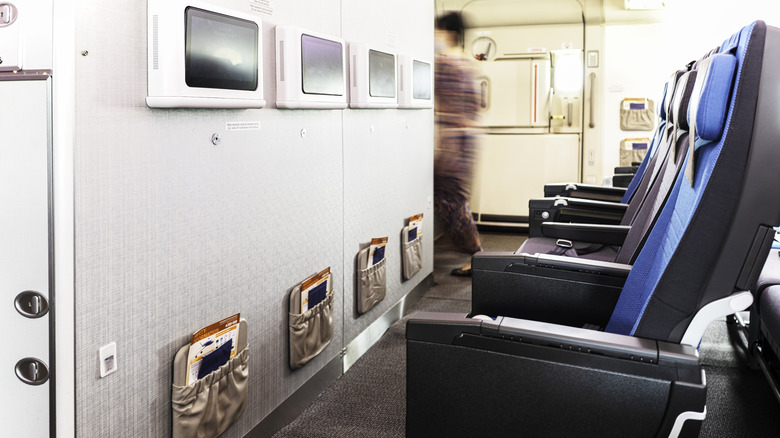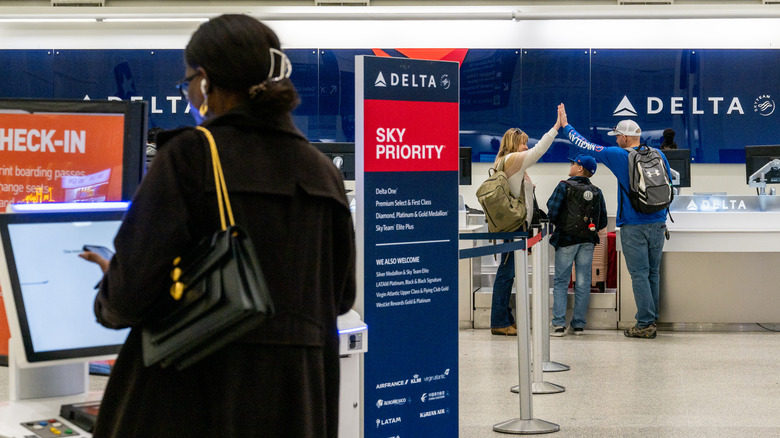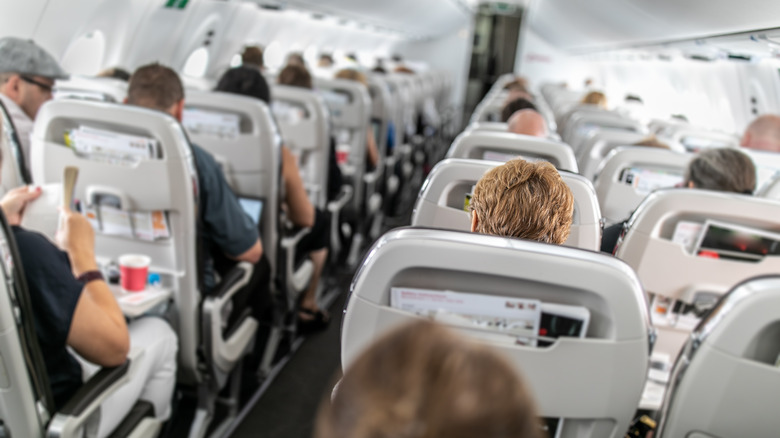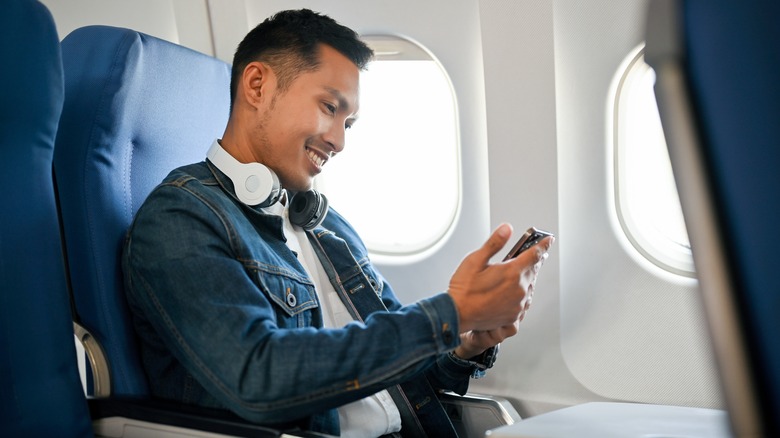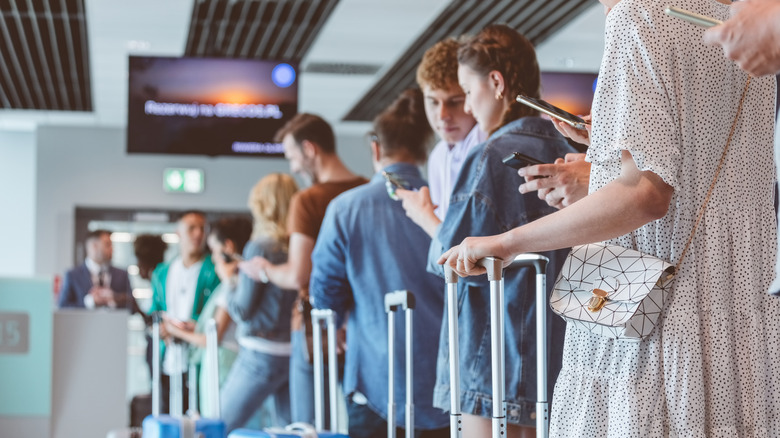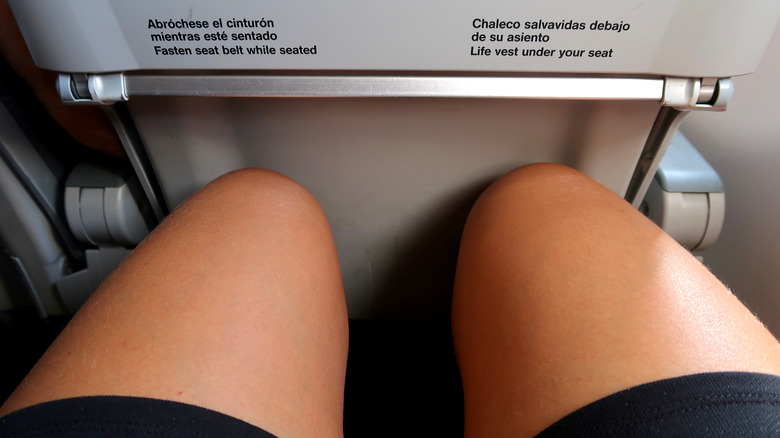Tips For Tall People That Will Make Your Next Flight Way More Comfortable
Sometimes, being tall is a blessing — but not when you're on a plane. While cramping yourself into an economy seat isn't comfortable for most people, it takes on a whole new level of discomfort if you're over a certain height, especially when embarking upon a long-haul journey.
Over the years, airlines across the globe have slowly but surely restricted legroom to squeeze as many passengers into the cabin as possible. According to Forbes, the average seat pitch — the industry term used for the space between each row of passengers — has plummeted from 31 to 35 inches in the 1980s to anywhere between 29 and 33 inches today, marking a whopping decrease of up to 17%.
What sounds like a small change can make a world of difference for the long-legged. The obvious solution is, of course, to upgrade to a more spacious seat. Unless you have deep pockets (or favorable airline status), this is easier said than done. As economy seats have shrunk, prices for seats in premium economy, business, and first-class cabins have skyrocketed. However, the good news is that there are still plenty of ways to ensure a comfy, cramp-free experience on your next plane journey.
Opt for the exit row
Securing extra legroom doesn't have to require a hefty upgrade fee. If you're in economy, the best way to maximize your space is to book a seat in the emergency exit row. These typically offer a seat pitch of 36 inches — considerably more spacious than other seats in the cabin — for passengers who confirm that they are capable of operating the exit door in the (unlikely) case of an emergency and are also over the age of 15.
While you'll often have to pay a small fee to preselect your seat (which can be slightly more for the exit row, purely because airlines know that everyone wants the extra room), it's much cheaper than upgrading to a higher class. If you don't choose the exit row in advance, it's always worth asking when checking in or once you're on the plane if it's still available and if you are able to swap seats for comfort reasons. If it so happens that nobody has booked these seats — and the flight attendant agrees to let you take the empty spot — just be aware that you probably won't be able to move until the plane hits cruising altitude for safety reasons.
Use SeatGuru
The emergency exit row isn't home to the only preferable seats in economy class. Depending on the plane, certain standard seats offer deceptively spacious legroom, which isn't widely advertised by the airline itself.
Websites like SeatGuru are your savior when choosing your spot. All you need to do is enter your flight number — or the airline, origin, and destination — to see seat maps for each flight. These use real reviews from previous passengers to indicate whether a seat is "good," "bad," or has "mixed reviews." Seats labeled "be aware" also warn of potential negatives that may detract from your flight experience.
For the tall folk among us, it's a great way of sourcing a hidden gem — such as seats without another chair in front — and avoiding those with red flags, such as limited seat back recline, proximity to the bathroom, or a pesky bulkhead that cuts into your legroom. If you haven't booked your flight yet, you can also compare your options to choose the airline or aircraft with the best choices.
Be selective with the day and time you fly
The fewer people on your flight, the more room you'll have to stretch out and get comfortable. While you can never guarantee an empty flight, certain times and days of the week have historically proven less popular with travelers.
Most of the year, Tuesdays and Wednesdays are the least busy (and least expensive) days to travel, while Friday is the busiest. If you opt to take a mid-week flight, you have a better chance of securing a row to yourself — or at least a neighboring empty seat — to sit diagonally and straighten out your legs. Saturdays are also often less popular, and early morning flights tend to be less crowded than those in the afternoon or evening (presumedly because fewer passengers are willing to drag themselves out of bed for a 4 a.m. check-in).
The only time these patterns don't necessarily hold true is during the holidays when the entire week is a free-for-all, and flights at all times of day are pretty much guaranteed to be fully booked. However, if you're booking close to your travel date, you can always call the airline to ask in advance just how busy your flight may be.
Wear compression socks
Compression socks are a must for passengers of all heights, especially those whose long legs limit the space they have to move and stretch mid-flight. Affordable and easy to find in pharmacies and on websites like Amazon, they work by gently squeezing your legs and feet to encourage blood circulation back up towards your heart.
Health-wise, these socks prevent swelling, numbness, and health issues like blood clots or deep vein thrombosis (DVT). However, they will also help reduce leg discomfort and numbness during your flight, both of which are even more common when your legs are just too long to get comfortable. They are especially helpful during long-haul flights when you often snooze your way through the journey (or if you're in a window seat and don't want to bother the stranger next to you with too many requests to climb over them and head out on a mid-flight aisle stroll).
Here's your advanced warning: Compression socks are fiddly to get on your feet at first. For that reason, we recommend squeezing them on before heading out to the airport to avoid any embarrassing fumbling once aboard the plane and keeping them on for the duration of the flight.
Choose your airline carefully
Certain airlines are renowned for offering more legroom in the economy cabin than others. The likes of Virgin Australia, South African Airways, Cathay Pacific, and Air Canada all boast greater seat pitch on their aircraft than other airlines. When it comes to short-haul flights, luxurious carriers like Emirates and Singapore Airlines have the most legroom at 32 to 34 inches, while Avianca and Malaysia Airlines have the most legroom on long-haul flights at up to 36 inches.
For domestic US flights, you'll find that JetBlue Airways gives you the most space to stretch your legs with an average seat pitch of 32.3 inches. The airline is famous for its dedication to customer comfort and markets "Even More Space" as a major perk for booking its flights.
Other than JetBlue, it should come as no surprise that budget airlines — such as Wizz Air, Jet2, Spirit Airlines, easyJet, and Frontier Airlines — offer the least legroom. While they'll almost always be the cheapest options, you may find yourself struggling to get comfortable with as little as 28 inches of legroom. However, don't mistake higher fares for extra legroom. Even pricier airlines — such as British Airways and KLM — boast average seat pitches closer to 29 inches.
Keep your armrest lifted
Raising the armrest once the plane is at cruising altitude is a tall-person tip that comes with a few caveats. Obviously, if you're sitting next to a stranger, they may not appreciate you eliminating the boundary between your seats and encroaching on their space (and we don't recommend taking the risk of confrontation).
However, if you're sitting next to friends or family, finding and pressing the button on the side of your armrest to raise it back between the seats will give you more space to wriggle around and sit at a more diagonal angle so you can stretch your legs out further. You'll also be able to lean on your companion more freely, which can be a huge relief comfort-wise (for you, at least).
Not every aircraft will have this feature — and the armrests between you and the aisle and you and the window typically won't lift — but it's always worth checking in case. Just remember that you'll need to keep the armrest down for takeoff and landing for safety reasons; if there is a sudden movement on your flight and the armrest is up, there's a risk of injury.
Avoid the bulkhead
Beware of the location of the bulkhead when choosing your seat. Also known as the wall partition that divides different classes on the plane, the bulkhead has many pros and cons for tall passengers.
Every inch of legroom counts when you're over a certain height, but if you're seated behind the bulkhead, the solid divider will reduce your legroom as you won't be able to stretch your feet underneath the chair in front. The seats also tend to be narrower than other seats in the cabin, and because there's no dedicated storage space, you'll have to keep all your belongings on your lap or your feet if you want them after takeoff. On the plus side, nobody can recline their seat onto your legs, and you should also have more room for your knees as the tray usually folds out of your armrest instead of folding out in front of you.
Meanwhile, sitting in front of a bulkhead will give you the same legroom as usual, plus somewhere to keep your belongings. However, it's still not the best spot for those over a certain height, as you won't be able to recline your seat (but the person in front will still be able to recline onto you).
Stay loyal to an airline
If you're a frequent flier, it can be beneficial to stick to one airline or at least one airline alliance scheme, such as SkyTeam or Oneworld, as you'll rapidly accumulate air miles every time you fly with this airline, any other airline in their alliance, or other partner airlines.
Not only will you eventually have enough miles to give yourself a free upgrade to business or first class — all of which will almost always come with more legroom — but as you climb the ranks, you may find yourself getting complimentary upgrades without having to spend a dime (or wasting any of your hard-earned miles).
To maximize your air mile savings, it's worth looking into other ways to accumulate miles in your day-to-day life. For example, Delta Air Lines and Alaska Airlines will allow you to earn air miles whenever you book a car journey via Lyft. while Uber offers the same as British Airways Multiple airlines will also give you miles when you book at certain partner hotel chains, rent a car, shop in some stores, or use specific credit cards that rack up miles whenever you make a purchase.
Make friends with the person in front of you
Reclining is a controversial topic among frequent fliers. Some argue that it's their god-given, airborne right, while others see it as a selfish practice that hinders the experience of the person behind them (and all the passengers behind them, as it triggers a domino effect of reclining).
If you're tall, it can be even more frustrating when the person in front of you chooses to recline — especially if they seemingly do so from the moment you hit cruising altitude to the second you come in for landing. To avoid the issue, try making friendly conversation with the person in front of you at the beginning of the flight and politely ask if they don't mind reclining once you're in the air, bringing up your height in the process. Of course, there's no guarantee that they'll say yes — and you can't force them not to — but it's always worth a shot.
Even if they do say no (or if you're too nervous to bring up the conversation), the flight attendant will almost always have your back about asking the passenger to raise their seat during the meal service, which is often the most uncomfortable part of flying as a tall person.
Buy a lumbar support pillow
Aches and pains are sadly very common after a long flight, especially if you've tried to cram long limbs into a small space for hours on end. For tall people, lower back discomfort is one of the most common irritations post-plane, but it can be easily relieved with the aid of a memory foam or inflatable lumbar support pillow.
This pillow sits between the chair and lower back to lessen pressure and give you more support during your flight. It's a tiny, inexpensive addition that will force good posture and make a noticeable difference comfort-wise when you get off the plane.
If you don't manage to locate one ahead of your trip, you can also ask a flight attendant if it's possible to grab a large, full water bottle. If there's one going spare, you just need to wrap it in a blanket and pop it sideways behind your lower back for a similar effect.
Board as early as possible
The space beneath the chair in front of you is critical for shuffling around and staying comfortable mid-flight. However, if you're forced to put your carry-on luggage under the seat, that poses a potential problem for you and your feet.
To ensure you have space to put your carry-on in the overhead bin, we recommend trying to board the flight as early as possible. Some airlines will allow you to purchase priority boarding ahead of time, while higher classes — such as business or premium economy — will typically board before the regular economy cabin. You may also get priority boarding thanks to your air mile status.
If you don't fall into any of these groups, you may have to rely on the tried-and-tested tactic of hovering at the gate so you can swoop into the line as soon as your boarding group (which is usually printed on your ticket) is called. We'd especially recommend this if you know or have noticed that your flight is particularly busy; the more people get on the plane before you, the more bags fill up the shelves and leave you with no personal space from the waist down.
Protect your knees
In 2014, a United Airlines flight from Newark to Denver was forced to make an unplanned landing in Chicago to disembark two passengers who got into a heated disagreement turned fight about the use of a Knee Defender — a device that locks onto the seat in front of you to forcibly stop it from reclining into your personal space.
Despite sales of the Knee Defender surging at a record pace after news broke of the incident, airlines worldwide explicitly banned the use of similar products (which can actually be seen as tampering with the plane and damaging both the tray tables and seats themselves). Invented by the 6-foot-3-inch Ira Goldman, the Knee Defender's original purpose was to protect the knees of tall passengers tired of being bumped and bruised by those napping in front of them.
Frustrating though it may be, ultimately, the passenger in front of you has the right to recline, which we do not have the right to control. To protect your knees without getting kicked off the plane or entering into a conflict with your fellow passengers, we recommend wearing long-legged clothing and using your blanket to keep your legs protected. You can also request a bonus blanket from the flight attendant for an added layer of padding.
